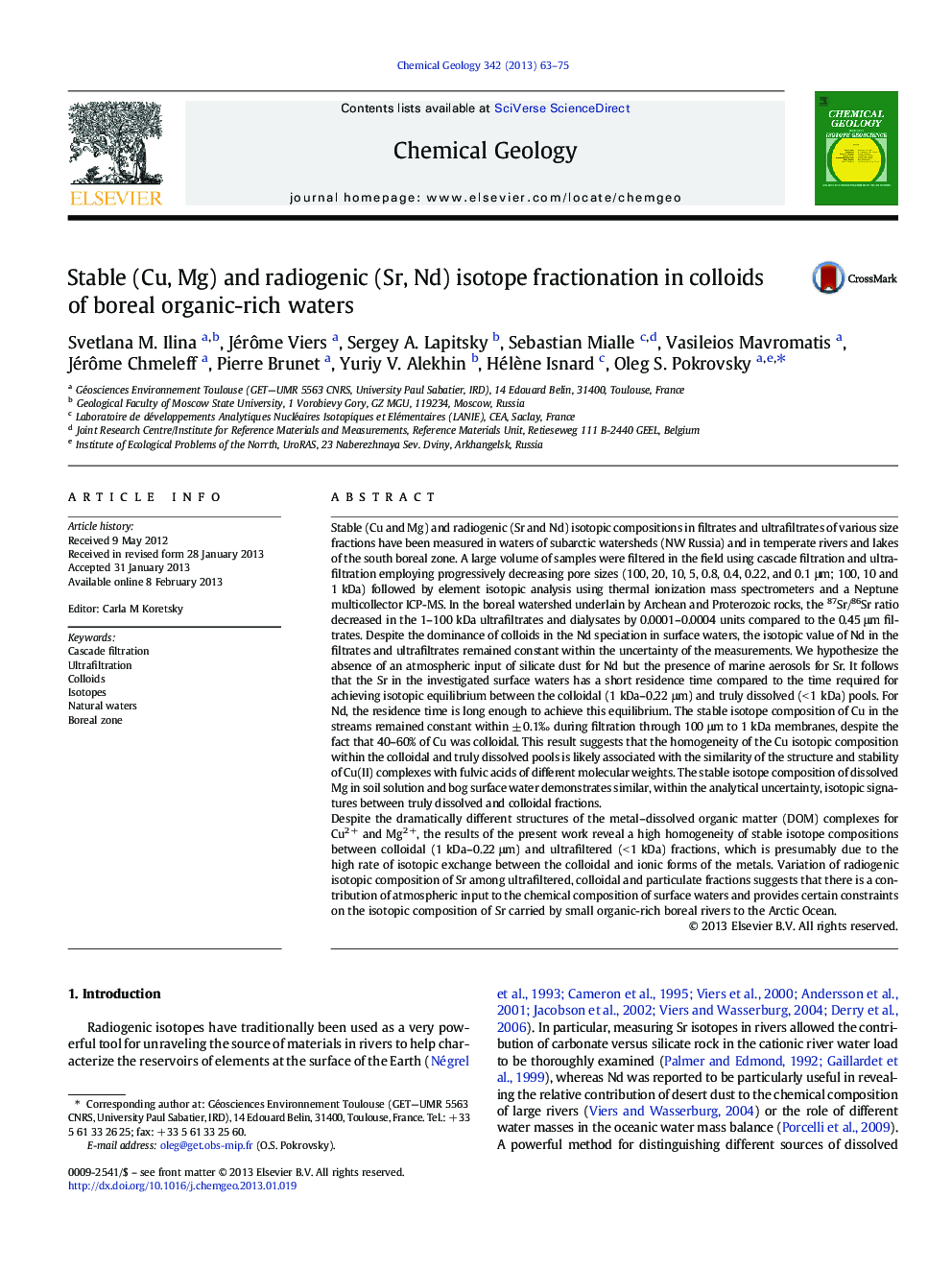| کد مقاله | کد نشریه | سال انتشار | مقاله انگلیسی | نسخه تمام متن |
|---|---|---|---|---|
| 4699070 | 1637626 | 2013 | 13 صفحه PDF | دانلود رایگان |

Stable (Cu and Mg) and radiogenic (Sr and Nd) isotopic compositions in filtrates and ultrafiltrates of various size fractions have been measured in waters of subarctic watersheds (NW Russia) and in temperate rivers and lakes of the south boreal zone. A large volume of samples were filtered in the field using cascade filtration and ultrafiltration employing progressively decreasing pore sizes (100, 20, 10, 5, 0.8, 0.4, 0.22, and 0.1 μm; 100, 10 and 1 kDa) followed by element isotopic analysis using thermal ionization mass spectrometers and a Neptune multicollector ICP-MS. In the boreal watershed underlain by Archean and Proterozoic rocks, the 87Sr/86Sr ratio decreased in the 1–100 kDa ultrafiltrates and dialysates by 0.0001–0.0004 units compared to the 0.45 μm filtrates. Despite the dominance of colloids in the Nd speciation in surface waters, the isotopic value of Nd in the filtrates and ultrafiltrates remained constant within the uncertainty of the measurements. We hypothesize the absence of an atmospheric input of silicate dust for Nd but the presence of marine aerosols for Sr. It follows that the Sr in the investigated surface waters has a short residence time compared to the time required for achieving isotopic equilibrium between the colloidal (1 kDa–0.22 μm) and truly dissolved (< 1 kDa) pools. For Nd, the residence time is long enough to achieve this equilibrium. The stable isotope composition of Cu in the streams remained constant within ± 0.1‰ during filtration through 100 μm to 1 kDa membranes, despite the fact that 40–60% of Cu was colloidal. This result suggests that the homogeneity of the Cu isotopic composition within the colloidal and truly dissolved pools is likely associated with the similarity of the structure and stability of Cu(II) complexes with fulvic acids of different molecular weights. The stable isotope composition of dissolved Mg in soil solution and bog surface water demonstrates similar, within the analytical uncertainty, isotopic signatures between truly dissolved and colloidal fractions.Despite the dramatically different structures of the metal–dissolved organic matter (DOM) complexes for Cu2 + and Mg2 +, the results of the present work reveal a high homogeneity of stable isotope compositions between colloidal (1 kDa–0.22 μm) and ultrafiltered (< 1 kDa) fractions, which is presumably due to the high rate of isotopic exchange between the colloidal and ionic forms of the metals. Variation of radiogenic isotopic composition of Sr among ultrafiltered, colloidal and particulate fractions suggests that there is a contribution of atmospheric input to the chemical composition of surface waters and provides certain constraints on the isotopic composition of Sr carried by small organic-rich boreal rivers to the Arctic Ocean.
Radiogenic isotopes Sr and Nd, stable isotopes of Cu and Mg in colloids and particlesFigure optionsDownload as PowerPoint slideHighlights
► Stable (Cu and Mg) and radiogenic (Sr and Nd) isotopes were measured in boreal colloids.
► Absence of atmospheric input of silicate dust for Nd
► Presence of marine aerosols for Sr
► Homogeneity of Cu isotopic composition within colloidal and truly dissolved pools
► Absence of Mg isotope fractionation between colloids and < 1 kDa fraction
Journal: Chemical Geology - Volume 342, 29 March 2013, Pages 63–75